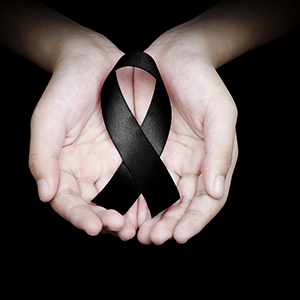According to the American Academy of Dermatology, skin cancer rates doubled from 1988 to 2019 in the United States. To be vigilant against skin cancer, it’s important to know the warning signs of melanoma and how to protect your skin from the harmful UV rays that can cause it.

Skin cancer warning signs you should never ignore
The best way to be on your guard against melanoma and other forms of skin cancer is to examine your skin regularly and know what to look for. When it comes to melanoma, our surgeons recommend following the ABCDE rule when checking your moles or if you notice a new mole.
- Asymmetry - a lack of symmetry between the two halves of the spot in question.
- Border - an irregular border that’s hard to define.
- Color - the skin spot has several different colors in varying shades of tan, black, brown, or areas of white, red or blue.
- Diameter - melanomas are typically bigger than 6mm in diameter, but they can be smaller.
- Evolving - when the spot starts to grow, change color, or change shape.
When to see a doctor
If you notice changes in skin spots such as a mole that grows rapidly, bleeds, ulcerates, has an irregular margin, or an unusual color distribution, you should see your primary care physician or a dermatologist right away. Melanoma is highly treatable when caught in the early stages. In fact, the average five-year survival rate for cases diagnosed before the melanoma spreads to the lymph nodes is 99%.
Melanoma treatment options
While melanoma is a very aggressive cancer, it’s also treatable. However, the success of treatment is largely dependent on the extent of the cancer upon diagnosis. Cancer confined to the skin has the best prognosis. Survival rates drop significantly once the disease has spread to the lymph nodes, organs or bones.
The surgical treatment of melanoma is determined by the thickness of the skin lesion. Thin tumors can be treated by wide local excision (with a one-centimeter margin around the lesion removed) and do not require lymph node biopsy. For thicker tumors or lesions, a wider margin and lymph node biopsy are necessary. These extra measures are to ensure that cancer hasn’t spread and to prevent local recurrance. In some cases, the lymph nodes closest to the lesion are removed to prevent further disease.
At Austin Surgeons, our board-certified general surgeons are committed to offering the highest level of patient-focused surgical care. Our goal is to provide the most appropriate treatment to provide a cure and also prevent the reoccurrence of melanoma.
Tips for protecting your skin from the sun
Melanoma and other forms of skin cancer are almost always caused by excessive exposure to UV light from the sun or tanning beds. By taking the following precautions, you can reduce your risk developing of skin cancer.
- Wear broad-spectrum sunscreen and sun-protective clothing
- Spend time in the shade, especially between 10am – 2pm when the sun’s rays are the strongest
- Water, sand, and snow magnify UV rays, so be extra careful near them
- NEVER lay inside a tanning bed
To learn more about the surgical treatment of melanoma, visit austinsurgeons.net or call 512-467-7151.
For the latest Austin Surgeons news, follow us on Facebook and Instagram.

